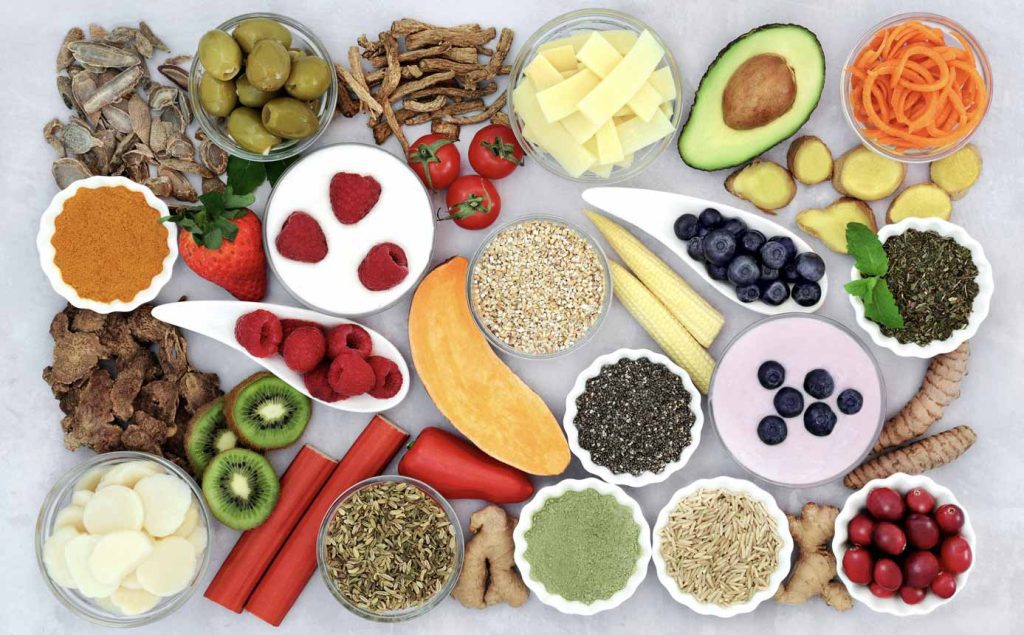Suffering from irritable bowel? If every meal fills you with fear of stomach pains, bloating, and the unpleasant time in the bathroom that will follow, you might want to try the food map method. The diet removes some delicious things from the menu but will help you stop suffering. So what is allowed and what is not allowed to eat?
Food Map (FODMAP) is a diet that aims to relieve the symptoms of those suffering from irritable bowel, as well as Crohn’s and endometriosis by giving up high-carbohydrate foods that weigh on the stomach.
The name of the diet is an acronym for the types of problematic carbohydrates.
Remove from the menu foods that contain them, and then add them one by one and check how the excitement is.
Not recommended: foods rich in gluten and lactose, some fruits and vegetables as well as silane and honey.
Recommended: foods low in gluten and lactose, for example buckwheat flour and low-lactose milk, and some fruits and vegetables.
Do you dream of pizza, but know that after two triangles you will find yourself writhing in pain? Do you fantasize about milkshakes, but every sip is mixed with the dread of the stomach aches that will come a little later? You may have irritable bowel (IBS) or in its more refined and more recent name: sensitive bowel.
Such is irritable bowel. This is a common chronic disorder. How common? The most common today is the digestive system. It is usually diagnosed after ruling out other symptoms, and its symptoms are very varied and are experienced to different degrees of intensity by different people: there are people for whom irritable bowel is a constant nightmare in life, and there are those who manage to live with it – even though it is not the most comfortable. But in neither case is the situation particularly pleasant.
Symptoms include abdominal pain, bloating, gas, constipation, or diarrhea (or both alternately). Many times the symptoms come sometime after the meal. The connection to food is not accidental. Two-thirds of those who suffer from it report a connection between what goes into their mouth and the onset of symptoms.
How are you treated? There are all kinds of ways to make it easier, and in the last decade, an approach has developed that is directly related to what you eat. It is called food map, (FODMAP), an acronym for types of carbohydrates that can cause the stomach to react with pain.
It was invented in Australia, and from there it continued all over the world, and with its help they identified and diagnosed several nutritional factors that may irritate and challenge the digestive system in people with irritable bowels.
Your bacteria are working too hard
The FODMAP diet is an elimination method, that is, a method in which “suspicious” foods are removed from the menu, especially those that contain certain carbohydrates (eg fructose, lactose, sorbitol, etc.), and check if the situation improves.
What have carbohydrates done to us? Some of them are not absorbed properly. On the other hand, they are well-digested by the bacteria in the intestines. These break them down and use them to grow and prosper.
The bacteria do this by fermenting the carbohydrates, and in this process gases, methane, and hydrogen are formed. We don’t feel the decomposition process, but we do feel the accumulation of gases and the disruption in the frequency of bowel movements (which manifests itself in increased bowel movements or constipation)…
We all have good bacteria in our digestive system. We have bacteria that live with us in symbiosis everywhere in the body: in the gut, on the skin, and in the eyes. This whole system of bacteria is called microbiota. Research shows that the bacteria that live with us play a central role in strengthening the body, and we derive a lot of benefits from their existence. Many of these bacteria live in our intestines.
The problem begins with those diagnosed with IBS, irritable bowel syndrome, when the body is only able to absorb a small portion of the carbohydrates, and therefore too much of them reach the bacteria. This creates an imbalance: the bacteria get too much food and work too much, and their increased activity causes much more bloating, gas, discomfort, and abdominal pain.
Carbohydrates also often cause large amounts of water to enter the intestines – another explanation for the feeling of fullness and bloating. A lot of water intake helps many people to evacuate in a better way, and this is one of the reasons why it is recommended to consume respectable amounts of fiber, but in some IBS patients, they can cause diarrhea.
Does someone diagnosed with irritable bowel need to limit the amount of dietary fiber? Yes, mainly because foods rich in fiber sometimes also have a lot of food from scratch.
Bye-bye croissant with chocolate
The types of carbohydrates that are avoided at the beginning of the process are fructose (fruit sugar), lactose (milk sugar), fructans (found in wheat, garlic, and onions), Galatians (found in legumes), polyols (often used in the artificial sweetener industry and naturally present in foods such as avocados and plums).
Studies show that limiting these carbohydrates reduces symptoms, especially those related to diarrhea and bloating. A positive change was also observed in about half of the Crohn’s and colitis patients who ate according to this method.
So what do you eat for irritable bowel?

Cereals and pastries: baked goods based on buckwheat flour (bread and pitas), buckwheat, rice of all colors (crisps, crackers, and rice noodles), corn (mamaliga, polenta), quinoa of all colors, tapioca, sorghum, millet, potato, and quark.
Please note: it is not the gluten that you are avoiding, but the fiber that is in the gluten-rich carbohydrates. That is, the method does not require you to avoid gluten, but to minimize the fiber found in the grains that contain it. Therefore, for example, you can eat products made from spelled flour.
Protein foods: meat, fish, eggs, hard tofu, and tempeh. Low-lactose dairy products such as hard cheeses (cottage, salty, yellow, cream cheese, mozzarella, butter) and low-lactose milk. Milk substitutes (rice/almond drink).
Legumes: 3 tablespoons of sprouted and cooked mashed beans, 1/4 cup of cooked legume, 1/2 cup of red beans.
Vegetables: Chinese sprouts (mash), alfalfa sprouts, carrots, endive, ginger, green beans, lettuce, chard, pak choi, Japanese pumpkin, red pepper, spinach, tomatoes, cucumber, zucchini, basil, cilantro, parsley, marjoram, mint, lemon, oregano, seaweed, eggplant, fennel, kale.
In a small amount (a quarter of a cup): leek leaves and green onion (the green part), radish.
Fruits: hard banana, cranberry (one tablespoon), melon, kiwi, lemon, tangerine and orange, papaya, sabers, pineapple, passion fruit, strawberries, carambola, raspberry, guava, pitaya (also known as dragon fruit and dragon fruit).
Fruit juices: theoretically you can drink up to half a glass a day, but in practice, this is not recommended because the amount of fruit sugar (fructose) is too large in all types of fruit. In short: it is better to avoid.
Fats: olive oil, canola, olives, macadamia, peanuts, walnuts, pine nuts, pecans, butter from these nuts, flax, chia, sesame, tahini, pumpkin, and sunflower seeds. Mayonnaise and mustard. Almonds and hazelnuts – allowed in moderate amounts, up to 10 units per day.
Sweeteners: sugar, maple, sucralose.
Sweets: Fur dark chocolate, waffles, and cookies without gluten and sugar substitutes, popcorn, gluten-free corn, and peanut snacks such as Bamba, sugar-based fruit jam.
And what else: soy sauce, vinegar, brewer’s yeast.
Please note: other foods can be eaten in smaller quantities. Since these are different quantities, they cannot be listed here. It is recommended to consult with a nutritionist who specializes in irritable bowel, and it is highly recommended to download one of the apps that lists the amounts of the pod from zero in the various foods.
And what don’t you eat for irritable bowel?
Cereals and pastries: wheat, barley, rye, pasta, couscous, flakes, noodles.
Protein foods: dairy products rich in lactose – milk, yogurt, sour cream, ice creams, milk powders, condensed milk, soft cheeses – ricotta, mascarpone, soy milk, and soy products other than tofu.
Legumes in large quantities.
Vegetables: artichoke, asparagus, beet, broccoli, cauliflower, cabbage, Brussels sprouts, garlic, onion, green pepper, mushrooms, porcini, chestnut squash.
Fruits: apple, pear, peach, plum, plum, watermelon, apricot, guava, cherries, lychee, dried fruits (dates, figs, and apricots), goji breeze, pomegranate.
Fats: pistachios, avocado, cashews.
Sweeteners: silane, honey, agave, sorbitol, mannitol, isomalate, maltitol, xylitol.
Sweets: milk chocolate, jams based on fruit concentrates (they are often written “jams without added sugar”), snacks based on corn syrup, dried fruits, fruit juices – up to half a glass a day, beyond that the amount of fruit sugar (fructose) is large too in all kinds of fruits.
And what else: coffee substitutes based on chicory and barley, inulin, miso, and tomato concentrate – in large quantities the fructose content is high.
Don’t eat all of these forever.
Don’t despair. You will give up these foods for 6 weeks, and then start to gradually put them back into the menu, one by one. If after a few days, the side effects do not return – you can conclude that this food does not bother you and integrate it back into the menu. This stage can be very confusing and stressful, so it is recommended to consult a nutritionist who specializes in irritable bowel.
Is it hard for you to last for 6 weeks? Are you unable to give up all your food at once? Ask your family doctor for a referral to a nutritionist who specializes in gastroenterology. She will help you do the process in an orderly manner that fits your regular menu and lifestyle.
And some important points
It may very well be that it is not only what you eat but how much. Even after you have successfully combined some of the foods, it is possible that if you eat a lot of them at once, say orange lentils, peach, and yogurt on the same day, you will feel unwell. This way you can conclude that a large amount is not good for you. Do not overload your stomach, eat a little of the “suspicious” foods every time.
There is something comforting about that. You will not be forced to avoid foods that taste good to you but oppress you forever. You can occasionally eat something that digests less well, as long as you don’t cross the threshold. What is the threshold? How much is too much for you? You will find out by trial and error.
In the same breath, it is important to note that people who suffer from irritable bowel are different from each other. There are those for whom legumes do not make a mess in their stomachs, but white flour causes a lot of trouble, And there are those for whom dairy products go well, but the fruits are oppressive, and there are countless other such examples. The solution is to listen to your stomach and your physical reactions after eating.
You may also find that what affects your eating the most is the time of the meal. Maybe you should eat a very small meal in the evening, and eat the main thing in the morning and noon?
And maybe it’s your mood that affects your digestive system – try to see if there is a connection between your emotions and the state of your digestive system. Mood, busyness, and stress often affect the functioning of the digestive system, and in some people, the effect is more significant than in others.
And a little tip about constipation:
make sure you drink enough water and that you consume enough fibrous foods low in food maps such as quark and strawberries. Follow the other basic instructions such as chewing well, eating slowly, and drinking plenty of fluids.
Also be sure to read the food labels and avoid prohibited foods, especially snacks and industrial food rich in fructose syrup, for example, sugar-free jams.
It is important to verify and rule out other factors that affect the digestive system. Pay attention if you drink enough or drink a lot of alcohol and caffeine, eat disorderly, or do not chew properly. seriously.
Is it “just” irritable bowel?
As mentioned, a diagnosis of irritable bowel syndrome is given after ruling out other health conditions, so it is important to contact a doctor or a gastro doctor who will talk to you, examine you and, if necessary, refer you for additional tests. And remember, the mental state also affects the state of the stomach. If you suffer from stress or anxiety, you deserve to feel good, treat them too.
You should follow the basic guidelines: eat small amounts spread out throughout the day and minimize heavy food: fat and meat, fried foods, and hard-to-digest fiber.
Recommended meals for happy stomachs
Breakfast:
water-based oatmeal, with brown sugar, hard banana, and cinnamon.
Or
apple rice flakes with almond milk, strawberries or melon, and a handful of chopped walnuts.
And if you want a sandwich:
2 slices of buckwheat bread with tahini and green cucumber.
Or
spelled flour pita with Bulgarian cheese and tomato.
Lunch for irritable bowel:
vegetable soup: 1/4 leek, fennel, cherry tomatoes, carrot, zucchini, and cilantro with chicken and buckwheat noodles.
Or
stir-fried tofu with green beans, carrots, and rice noodles.
Or
quinoa salad, zucchini, and eggplant antipasti with lettuce and sunflower seeds in pesto sauce.
Dinner for irritable bowel:
fresh tomato and zucchini stew with rice and tahini.
Or
potatoes, peppers, and fish baked in the oven in olive oil with herbs.
Or
an omelet, a slice of yellow cheese, 2 slices of spelled bread, and a salad that includes tomato, cucumber, carrot, lettuce, and cilantro.
Snacks for irritable bowel:
sweet/salty rice crispies.
or
dark chocolate, 70% cocoa.
Or
an orange or hard banana with a handful of walnuts and pecans.
or
Energy balls that contain cocoa, oats, tahini, and maple.












Add Comment